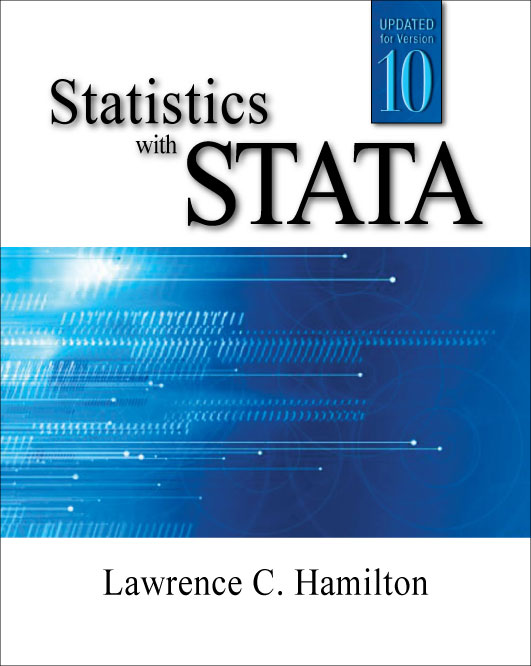| |
Statistics with Stata (Updated for Version 10)
by Lawrence C. Hamilton

Statistics with Stata (Updated for Version 10) is
the latest edition in Professor Lawrence C. Hamilton’s popular
Statistics with Stata series. Intended to bridge the gap between
statistical texts and Stata’s own documentation, Statistics with Stata
demonstrates how to use Stata to perform a variety of tasks. This text
is ideal as a self-study course for those new to statistics or those
migrating from other statistical software to Stata and as a valuable
reference for experienced Stata users wishing to explore Stata’s
capabilities in fields new to them.
Hamilton covers topics including getting started in Stata, data
manipulation, graphics, summary statistics and tables, ANOVA, linear
regression (and diagnostics), curve fitting, robust methods, regression
models for limited dependent variables, panel (longitudinal) data and
mixed models, survey data, survival analysis, factor analysis, cluster
analysis, time series, and an introduction to programming.
Notable changes to Statistics with Stata (Updated for Version 10)
include a new chapter on survey data analysis using Stata’s svy: prefix
command and a chapter on the multilevel and mixed model commands
introduced in Stata 10. Chapter 3, covering graphics, has been updated
to include a section demonstrating Stata’s Graph Editor. The entire
book has also been updated to reflect changes in output, syntax, and
features.
Table of contents
Preface
1 Stata and Stata
Resources
- A Typographical Note
- An Example Stata Session
- Stata's Documentation and Help Files
- Searching for Information
- StataCorp
- Statalist
- The Stata Journal
- Books Using Stata
2 Data Management
- Example Commands
Creating a New Dataset
Specifying Subsets of the Data: in and if Qualifiers
Generating and Replacing Variables
Missing Value Codes
Using Functions
Converting between Numeric and String Formats
Creating New Categorical and Ordinal Variables
Using Explicit Subscripts with Variables
Importing Data from Other Programs
Combining Two or More Stata Files
Transposing, Reshaping, or Collapsing Data
Using Weights
Creating Random Data and Random Samples
Writing Programs for Data Management
Managing Memory
3 Graphs
- Example Commands
Histograms
Scatterplots
Line Plots
Connected-Line Plots
Other Twoway Plot Types
Box Plots
Pie Charts
Bar Charts
Dot Plots
Symmetry and Quantile Plots
Adding Text to Graphs
Overlaying Multiple Twoway Plots
Graphing with Do-Files
Retrieving and Combining Graphs
Graph Editor
Creative Graphing
4 Summary Statistics and
Tables
- Example Commands
Summary Statistics for Measurement Variables
Exploratory Data Analysis
Normality Tests and Transformations
Frequency Tables and Two-Way Cross-Tabulations
Multiple Tables and Multi-Way Cross-Tabulations
Tables of Means, Medians, and Other Summary Statistics
Using Frequency Weights
5 ANOVA and Other
Comparison Methods
- Example Commands
One-Sample Tests
Two-Sample Tests
One-Way Analysis of Variance (ANOVA)
Two- and N-Way Analysis of Variance
Analysis of Covariance (ANCOVA)
Predicted Values and Error-Bar Charts
6 Linear Regression
Analysis
- Example Commands
The Regression Table
Multiple Regression
Predicted Values and Residuals
Basic Graphs for Regression
Correlations
Hypothesis Tests
Dummy Variables
Automatic Categorical-Variable Indicators and Interactions
Stepwise Regression
Polynomial Regression
7 Regression
Diagnostics
- Example Commands
- SAT Score Regression, Revisited
- Diagnostic Plots
- Diagnostic Case Statistics
- Multicollinearity
8 Fitting Curves
- Example Commands
- Band Regression
- Lowess Smoothing
- Regression with Transformed Variables — 1
- Regression with Transformed Variables — 2
- Conditional Effect Plots
- Nonlinear Regression — 1
- Nonlinear Regression — 2
9 Robust Regression
- Example Commands
- Regression with Ideal Data
- Y Outliers
- X Outliers (Leverage)
- Asymmetrical Error Distributions
- Robust Analysis of Variance
- Further rreg and qreg Applications
- Robust Estimates of Variance — 1
- Robust Estimates of Variance — 2
10 Logistic Regression
- Example Commands
- Space Shuttle Data
- Using Logistic Regression
- Conditional Effect Plots
- Diagnostic Statistics and Plots
- Logistic Regression with Ordered-Category y
- Multinomial Logistic Regression
11 Survival and
Event-Count Models
- Example Commands
- Survival-Time Data
- Count-Time Data
- Kaplan–Meier Survivor Functions
- Cox Proportional Hazard Models
- Exponential and Weibull Regression
- Poisson Regression
- Generalized Linear Models
12 Principal Components,
Factor, and Cluster Analysis
- Example Commands
- Principal Components
- Rotation
- Factor Scores
- Principal Factoring
- Maximum-Likelihood Factoring
- Cluster Analysis — 1
- Cluster Analysis — 2
13 Time Series
Analysis
- Example Commands
- Smoothing
- Further Time Plot Examples
- Lags, Leads, and Differences
- Correlograms
- ARIMA Models
- ARMAX Models
14 Survey Data Analysis
- Example Commands
Probability Weights
Poststratification Weights
Declare Survey Data
Survey-Weighted Tables and Graphs
Regression-Type Modeling
Conditional Effect Plots for Interactions
Other Tools for Survey Analysis 15 Multilevel and Mixed-Effects Modeling
Example Commands
Regression with Random Intercepts
Random Intercepts and Slopes
Multiple Random Slopes
Nested Levels
Cross-Sectional Time Series
Mixed-Effects Logit Regression
16 Introduction to Programming
Basic Concepts and Tools
Example Program: Moving Autocorrelation
Ado-File
Help File
Example Program: Plot Survey Variables
Monte Carlo Simulation
Matrix Programming with Mata
References
Index


|
|



